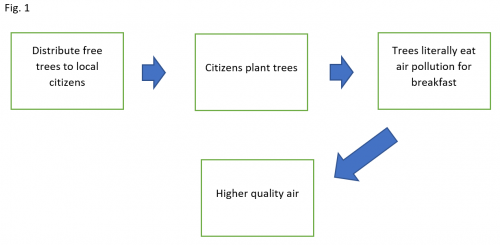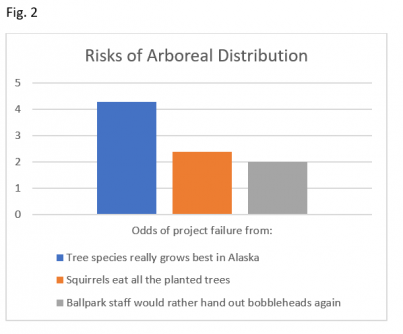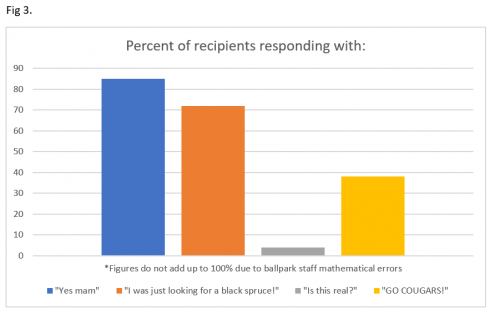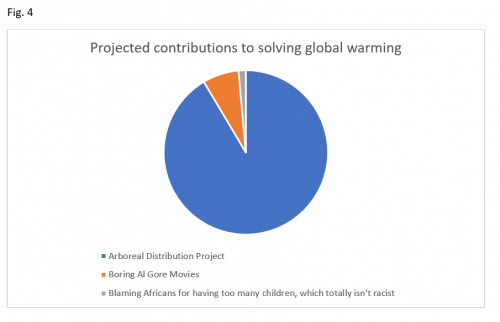How philanthropy’s obsession with metrics makes complete gibberish out of grant proposals.
One of the consistent themes of Philanthropy Daily over the years has been a healthy skepticism of philanthropy’s long obsession with metrics. Metrics to measure impact, metrics to measure effectiveness, metrics to reduce irreducibly human interactions to cold and calculating numbers, and even metrics to measure metrics.
Actually, there’s not enough of that last category—I don’t think the strategic philanthropists and “Effective Altruists” would like the results of those studies.
Free Trees at the Ballpark
Earlier this year, I happened to take my three-year-old to the ballpark. I watched the local minor league team play baseball. My three-year-old watched the guy selling cotton candy. It was a good day’s fun for all parties.
But upon leaving the stadium, we were greeted one last time by an employee, who shoved a small plastic bag into my hand.
“Happy Earth Day!” she said. I turned the bag around as I kept walking. I was stunned. It was a tiny seedling. A tree. A coniferous tree. A black spruce.
What was I supposed to do with it? When I moved into my home a couple of years ago, I planted a few dwarf fruit trees in my small yard, hoping that they’ll someday produce something tasty. I don’t have room, anywhere, for a black spruce. Do you know they can grow 65 feet tall?
I briefly had the thought that perhaps I was supposed to sneak into a park late at night with a shovel and plant it in the dark when no one could see me. Or maybe go to a local Wal-Mart and clandestinely plant it in some parking lot median, a one-tree protest against the soulless concrete surrounding the island of soil.
I looked at the tree in its plastic baggy. I looked at my son, his mouth covered in cotton candy fluff. I looked at the trash can near where had parked the car.
I threw the tree away. I saw others do the same. It felt terrible—why did the lady at the ballpark make me do this? Worst Earth Day ever.
And then it hit me: somewhere, the following grant report exists. It is the only explanation:
MAKING AN IMPACT
COMPLIMENTARY ARBOREAL DISTRIBUTIONS TO REDUCE CO2 LEVELS IN AMERICA’S SUBURBS
Thanks to a grant from the Grueling Application Foundation, the Earth Day Institute, partnering with local minor league baseball teams around the country, has embarked upon a bold and ambitious plan to reduce carbon dioxide levels in strategic locations. Unlike all previous philanthropic efforts, we sought to address root causes of the problem of air pollution rather than merely treating symptoms. No really, we’re pretty sure we’re the first to put it like that.
Our at once totally innovative and yet already well-proven model (per foundation requirements) shows that we’ll achieve the desired outcomes and address root causes only by handing out literal roots. Please see Fig. 1, which took our executive team 3 weeks to approve, leaving only 5 minutes before your deadline for our designer to make.

We understand that there may be many objections to this model. For example, handing out free trees at baseball games might encourage more people to attend baseball games, an environmentally wasteful activity that most people drive to before consuming completely unnatural substances, like cotton candy.
We also considered the fact that our plan might backfire if too many of the trees died once planted. But to fulfill reporting requirements we paid a previously unemployed guy with a Master’s in Economics from an online university to crunch the numbers for us, and we decided that those risks weren’t as dangerous to our model as we believe. See figure 2.

OUTCOMES
Of course, whatever isn’t measured doesn’t count, including costs that we will conveniently not measure so we don’t have to take them into account. Because our only inputs are massive quantities of black spruce tree seedlings (strategically chosen for their cheap price and fitness for many different environments) and small plastic bags recycled from all the small plastic bags sent to the landfill by recipients of last year’s tree distribution, our costs were kept low.
We completed a rigorous survey of ballpark staff tasked with tree distribution, which honestly used up most of this grant. Staff were instructed to ask each tree recipient, “It’s Earth Day. You are going to plant this tree at home, aren’t you?”, and make a wave of their hand as though performing the Jedi Mind Trick. Please see results in Figure 3.

On the basis of this survey, we estimate that approximately 95% of trees will be planted and grow to adulthood in the yards of their owners. 4% will be cut down as Christmas trees within the first 10 years of their life, and the remaining 1% will die in unfortunate T-ball related accidents.
But that’s not all. Trees reproduce. So an investment in our project is an investment in our future, and our children’s future, and their future’s future. If just 30% of our black spruce trees produce little baby black spruce trees, and just 30% of those produce more black spruce trees, we estimate that global warming will be solved entirely by 2038, and that the entire arable surface of the Earth will be covered in black spruce trees by 2072, including the offices of the Earth Day Institute and the ballparks where distribution would normally take place, which will permanently end the project in its current form.
Please see figure 4 for our estimation of our role—and yours as our most important funder!—in solving these global problems.

In conclusion, we thank the Grueling Application Foundation for its grant of $50,000, which almost covered the staggering amount of staff time and outside consulting fees we sunk into creating the B.S. logic model in Appendix B. We’ll send you some trees.





